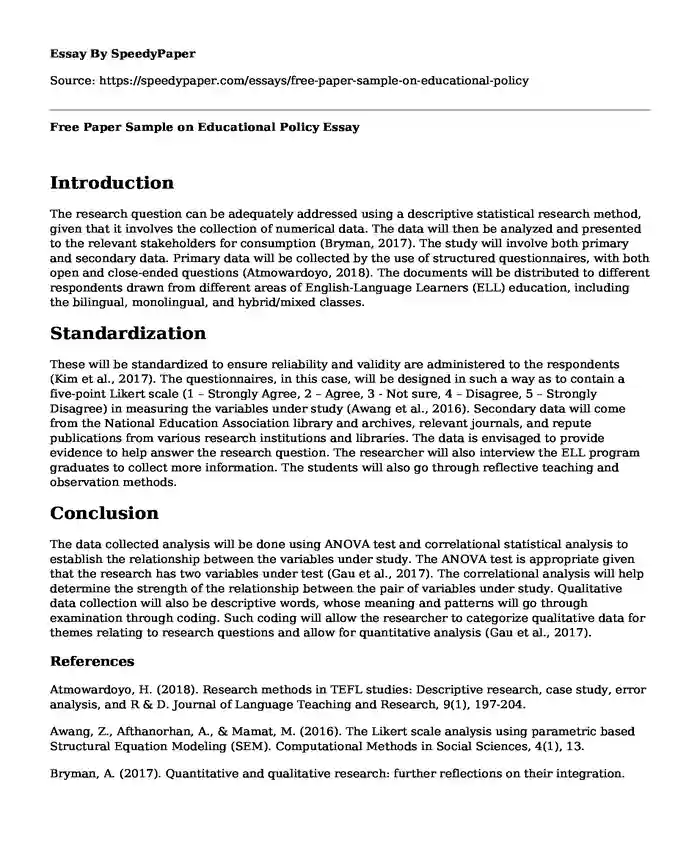
| Type of paper: | Essay |
| Categories: | Policy Education Data analysis |
| Pages: | 2 |
| Wordcount: | 436 words |
Introduction
The research question can be adequately addressed using a descriptive statistical research method, given that it involves the collection of numerical data. The data will then be analyzed and presented to the relevant stakeholders for consumption (Bryman, 2017). The study will involve both primary and secondary data. Primary data will be collected by the use of structured questionnaires, with both open and close-ended questions (Atmowardoyo, 2018). The documents will be distributed to different respondents drawn from different areas of English-Language Learners (ELL) education, including the bilingual, monolingual, and hybrid/mixed classes.
Standardization
These will be standardized to ensure reliability and validity are administered to the respondents (Kim et al., 2017). The questionnaires, in this case, will be designed in such a way as to contain a five-point Likert scale (1 – Strongly Agree, 2 – Agree, 3 - Not sure, 4 – Disagree, 5 – Strongly Disagree) in measuring the variables under study (Awang et al., 2016). Secondary data will come from the National Education Association library and archives, relevant journals, and repute publications from various research institutions and libraries. The data is envisaged to provide evidence to help answer the research question. The researcher will also interview the ELL program graduates to collect more information. The students will also go through reflective teaching and observation methods.
Conclusion
The data collected analysis will be done using ANOVA test and correlational statistical analysis to establish the relationship between the variables under study. The ANOVA test is appropriate given that the research has two variables under test (Gau et al., 2017). The correlational analysis will help determine the strength of the relationship between the pair of variables under study. Qualitative data collection will also be descriptive words, whose meaning and patterns will go through examination through coding. Such coding will allow the researcher to categorize qualitative data for themes relating to research questions and allow for quantitative analysis (Gau et al., 2017).
References
Atmowardoyo, H. (2018). Research methods in TEFL studies: Descriptive research, case study, error analysis, and R & D. Journal of Language Teaching and Research, 9(1), 197-204.
Awang, Z., Afthanorhan, A., & Mamat, M. (2016). The Likert scale analysis using parametric based Structural Equation Modeling (SEM). Computational Methods in Social Sciences, 4(1), 13.
Bryman, A. (2017). Quantitative and qualitative research: further reflections on their integration.
In Mixing methods: Qualitative and quantitative research (pp. 57-78). Routledge.
Gau, J. M., Gursoy, D., & Sirakaya-Turk, E. (2017). Relationship analysis: t-tests, analysis of variance, cross tabulations and non-parametric tests. Research methods for leisure, recreation and tourism, (Ed. 2), 284-303.
Kim, H., Sefcik, J. S., & Bradway, C. (2017). Characteristics of qualitative descriptive studies: A systematic review. Research in nursing & health, 40(1), 23-42.
Cite this page
Free Paper Sample on Educational Policy. (2023, Dec 25). Retrieved from https://speedypaper.com/essays/free-paper-sample-on-educational-policy
Request Removal
If you are the original author of this essay and no longer wish to have it published on the SpeedyPaper website, please click below to request its removal:
- Temple of Caesar, Art Essay Sample for Students
- Essay Sample on Effects of Automobile
- Essay Example: ET Culture, Close Encounters of the Nth Kind
- Free Essay Focusing on Early Childhood Education Program
- Essay Sample - Policy Health Issue
- Paper Example. Deterrence Theory in Criminology
- Argumentative Essay: Social Media and the False Claims About Trump's Administration
Popular categories




